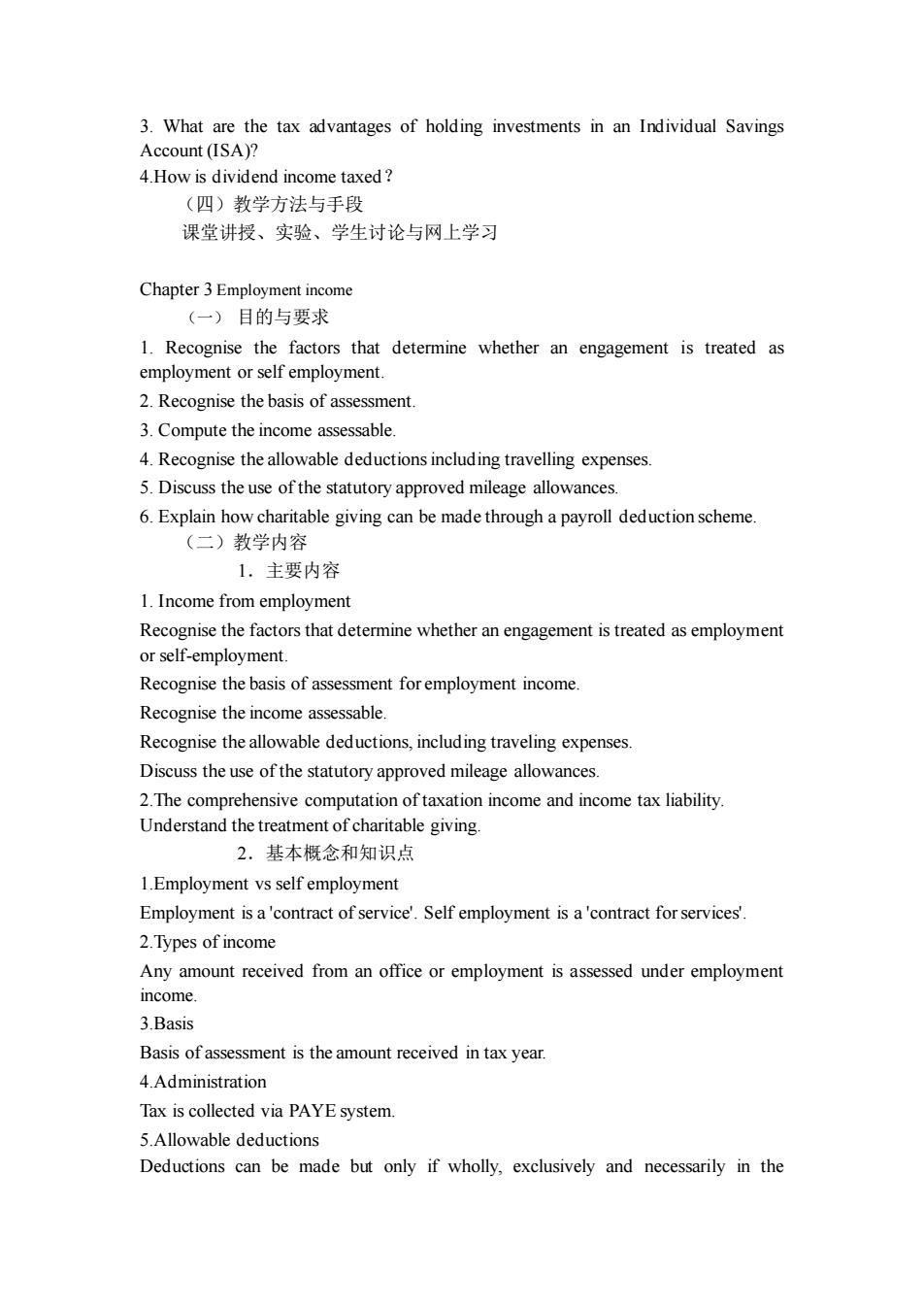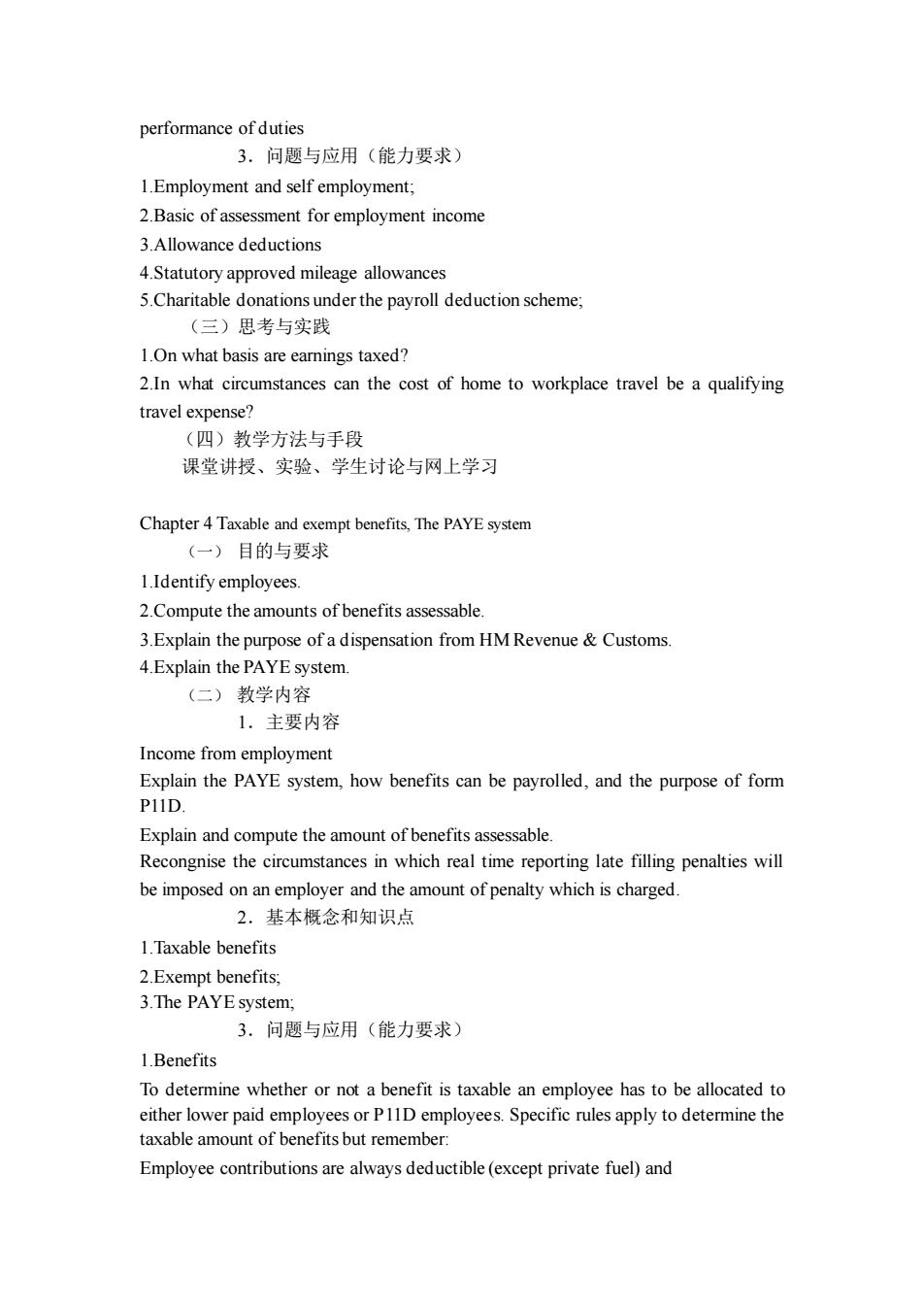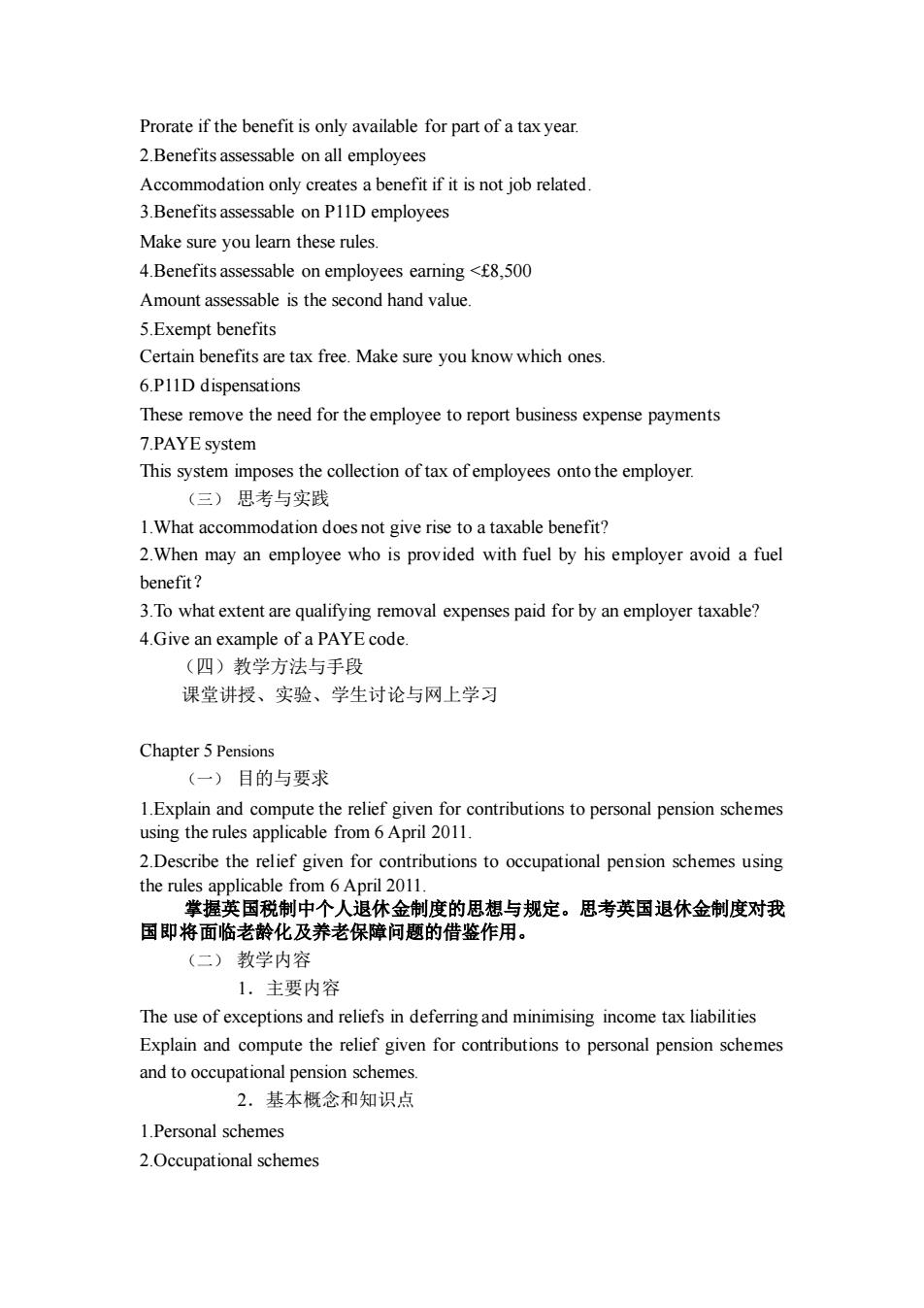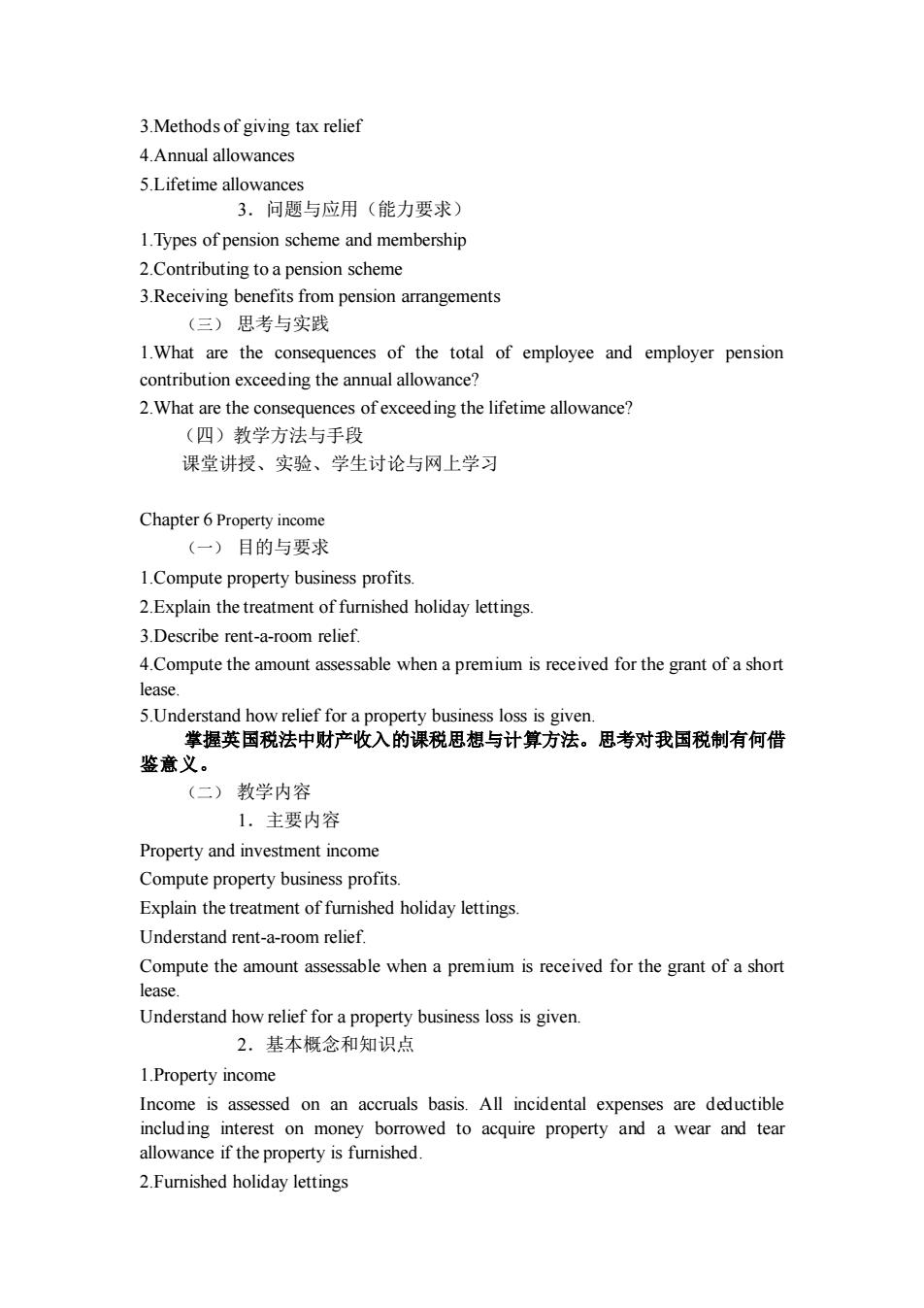
3.What are the tax advantages of holding investments in an Individual Savings Account(ISA)? 4.How is dividend income taxed? (四)教学方法与毛段 课堂讲授、实验、学生讨论与网上学习 Chapter 3 Employment income (一)目的与要求 1.Recognise the factors that determine whether an engagement is treated as employment or self employmen 2.Recognise the basis of assessment. 3.Compute the income assessable. 4.Recognise the allowable deductions including travelling expenses 5.Discuss the use of the statutory approved mileage allowances. 6.Explain how charitable giving can be made through a payroll deduction scheme (二)教学内容 1.主要内容 1.Income from employment Recognise the factors that determine whether an engagement is treated as employment or self-employment Recognise the basis of assessment for employment income Recognise the income assessable. Recognise the allowable deductions,including traveling expenses. Discuss the use of the statutory approved mileage allowances 2.The comprehensive computation of taxation income and income tax liability. Understand the treatment of charitable giving. 2.基本概念和知识点 1.Employment vs self employment Employment is a'contract of service'Self employment is a 'contract for services' 2.Types of income Any amount received from an office or employment is assessed under employment ncome 3.Basis Basis of assessment is the amount received in tax year. 4.Administration Tax is collected via PAYE system. 5.Allowable deductions Deductions can be made but only if wholly,exclusively and necessarily in the
3. What are the tax advantages of holding investments in an Individual Savings Account (ISA)? 4.How is dividend income taxed? (四)教学方法与手段 课堂讲授、实验、学生讨论与网上学习 Chapter 3 Employment income (一) 目的与要求 1. Recognise the factors that determine whether an engagement is treated as employment or self employment. 2. Recognise the basis of assessment. 3. Compute the income assessable. 4. Recognise the allowable deductions including travelling expenses. 5. Discuss the use of the statutory approved mileage allowances. 6. Explain how charitable giving can be made through a payroll deduction scheme. (二)教学内容 1.主要内容 1. Income from employment Recognise the factors that determine whether an engagement is treated as employment or self-employment. Recognise the basis of assessment for employment income. Recognise the income assessable. Recognise the allowable deductions, including traveling expenses. Discuss the use of the statutory approved mileage allowances. 2.The comprehensive computation of taxation income and income tax liability. Understand the treatment of charitable giving. 2.基本概念和知识点 1.Employment vs self employment Employment is a 'contract of service'. Self employment is a 'contract for services'. 2.Types of income Any amount received from an office or employment is assessed under employment income. 3.Basis Basis of assessment is the amount received in tax year. 4.Administration Tax is collected via PAYE system. 5.Allowable deductions Deductions can be made but only if wholly, exclusively and necessarily in the

performance of duties 3.问题与应用(能力要求) 1.Employment and self employment: 2.Basic of assessment for employment income 3.Allowance deductions 4.Statutory approved mileage allowances 5.Charitable donations under the payroll deduction scheme; (三)思考与实践 1.On what basis are earnings taxed? 2.In what circumstances can the cost of home to workplace travel be a qualifying travel expense? (四)教学方法与手段 课堂讲授、实验、学生讨论与网上学习 Chapter 4 Taxable and exempt benefits.The PaYe system (一)目的与要求 1.Identify employees 2.Compute the amounts of benefits assessable. 3.Explain the purpose ofa dispensation from HM Revenue&Customs. 4.Explain the PAYE system. (二)教学内容 1.主要内容 Income from employment Explain the PAYE system,how benefits can be payrolled,and the purpose of form Explain and compute the amount of benefits assessable Recongnise the circumstances in which real time reporting late filling penalties will be imposed on an employer and the amount of penalty which is charged. 2.基本概念和知识点 1.Taxable benefits 2.Exempt benefits; 3.问题与应用(能力要求) 1.Benefits To determine whether or not a benefit is taxable an emplovee has to be allocated to mplo yees or P11D employees.Specific rules apply to determine the Employee contributions are always deductible(except private fuel)and
performance of duties 3.问题与应用(能力要求) 1.Employment and self employment; 2.Basic of assessment for employment income 3.Allowance deductions 4.Statutory approved mileage allowances 5.Charitable donations under the payroll deduction scheme; (三)思考与实践 1.On what basis are earnings taxed? 2.In what circumstances can the cost of home to workplace travel be a qualifying travel expense? (四)教学方法与手段 课堂讲授、实验、学生讨论与网上学习 Chapter 4 Taxable and exempt benefits, The PAYE system (一) 目的与要求 1.Identify employees. 2.Compute the amounts of benefits assessable. 3.Explain the purpose of a dispensation from HM Revenue & Customs. 4.Explain the PAYE system. (二) 教学内容 1.主要内容 Income from employment Explain the PAYE system, how benefits can be payrolled, and the purpose of form P11D. Explain and compute the amount of benefits assessable. Recongnise the circumstances in which real time reporting late filling penalties will be imposed on an employer and the amount of penalty which is charged. 2.基本概念和知识点 1.Taxable benefits 2.Exempt benefits; 3.The PAYE system; 3.问题与应用(能力要求) 1.Benefits To determine whether or not a benefit is taxable an employee has to be allocated to either lower paid employees or P11D employees. Specific rules apply to determine the taxable amount of benefits but remember: Employee contributions are always deductible (except private fuel) and

Prorate if the benefit is only available for part of a tax year 2.Benefits assessable on all employees Accommodation only creates a benefit if it is not job related 3.Benefits assessable on P11D employees Make sure you leam these rules. 4.Benefits assessable on employees earning<f8.500 Amount assessable is the second hand value. 5.Exempt benefits Certain benefits are tax free.Make sure you know which ones 6.P11D dispensations These remove the need for the employee to report business expense payments 7PAYE system This system imp oses the collection of tax ofemployees onto the employe (三)思考与实践 1.What accommodation does not give rise to a taxable benefit? 2.When may an employee who is provided with fuel by his employer avoid a fuel benefit? 3.To what extent are qualifying removal expenses paid for by an employer taxable? 4.Give an example of a PAYEcode (四)教学方法与手段 课堂讲授、实验、学生讨论与网上学习 Chapter 5 Pensions (一)目的与要求 1.Explain and compute the relief given for contributions to personal pension schemes using the rules applicable from 6 April 2011. 2.Describe the relief given for contributions to occupational pension schemes using the rules applicable from 6A April 2011 掌握英国税制中个人退休金制度的思想与规定。思考英国退休金制度对我 国即将面临老龄化及养老保障问题的借鉴作用。 (二)教学内容 1.主要内容 The use of exceptions and reliefs in deferring and minimising income tax liabilities Explain and compute the relief given for contributions to personal pension schemes and to occupational pension schemes 2.基本概念和知识点 1.Personal schemes 2.Occupational schemes
Prorate if the benefit is only available for part of a tax year. 2.Benefits assessable on all employees Accommodation only creates a benefit if it is not job related. 3.Benefits assessable on P11D employees Make sure you learn these rules. 4.Benefits assessable on employees earning <£8,500 Amount assessable is the second hand value. 5.Exempt benefits Certain benefits are tax free. Make sure you know which ones. 6.P11D dispensations These remove the need for the employee to report business expense payments 7.PAYE system This system imposes the collection of tax of employees onto the employer. (三) 思考与实践 1.What accommodation does not give rise to a taxable benefit? 2.When may an employee who is provided with fuel by his employer avoid a fuel benefit? 3.To what extent are qualifying removal expenses paid for by an employer taxable? 4.Give an example of a PAYE code. (四)教学方法与手段 课堂讲授、实验、学生讨论与网上学习 Chapter 5 Pensions (一) 目的与要求 1.Explain and compute the relief given for contributions to personal pension schemes using the rules applicable from 6 April 2011. 2.Describe the relief given for contributions to occupational pension schemes using the rules applicable from 6 April 2011. 掌握英国税制中个人退休金制度的思想与规定。思考英国退休金制度对我 国即将面临老龄化及养老保障问题的借鉴作用。 (二) 教学内容 1.主要内容 The use of exceptions and reliefs in deferring and minimising income tax liabilities Explain and compute the relief given for contributions to personal pension schemes and to occupational pension schemes. 2.基本概念和知识点 1.Personal schemes 2.Occupational schemes

3.Methodsof giving tax relief 4.Annual allowances 5.Lifetime allowances 3.问题与应用(能力要求) 1.Types of pension scheme and membership 2.Contributing to a pension scheme 3.Receiving benefits from pension arrangements (三)思考与实践 1.What are the consequences of the total of employee and employer pension contribution exceeding the annual allowance? 2.What are the consequences of exceeding the lifetime allowance? (四)教学方法与手段 课堂讲授、实验、学生讨论与网上学习 Chapter 6 Property income (一)目的与要求 1.Compute property business profits. 2.Explain the treatment of fumished holiday lettings. 3.Describe rent-a-room relief. 4.Compute the amount assessable when a premium is received for the grant of a short lease 5.Understand a property business ss is gv 握英国税法中财产收入的课税思想与计算方法。思考对我国税制有何借 鉴意义。 (二)教学内容 1.主要内容 Property and investment income Compute property business profits Explain the treatment of furnished holiday lettings Understand rent-a-room relief. Compute the amount assessable when a premium is received for the grant of a short lease Understand how relief for a property business loss is given 2.基本概念和知识点 1.Property income Income is assessed on an accruals basis.All incidental expenses are deductible including interest on money borrowed to acquire property and a wear and tear allowance if the property is furnished. 2.Furnished holiday lettings
3.Methods of giving tax relief 4.Annual allowances 5.Lifetime allowances 3.问题与应用(能力要求) 1.Types of pension scheme and membership 2.Contributing to a pension scheme 3.Receiving benefits from pension arrangements (三) 思考与实践 1.What are the consequences of the total of employee and employer pension contribution exceeding the annual allowance? 2.What are the consequences of exceeding the lifetime allowance? (四)教学方法与手段 课堂讲授、实验、学生讨论与网上学习 Chapter 6 Property income (一) 目的与要求 1.Compute property business profits. 2.Explain the treatment of furnished holiday lettings. 3.Describe rent-a-room relief. 4.Compute the amount assessable when a premium is received for the grant of a short lease. 5.Understand how relief for a property business loss is given. 掌握英国税法中财产收入的课税思想与计算方法。思考对我国税制有何借 鉴意义。 (二) 教学内容 1.主要内容 Property and investment income Compute property business profits. Explain the treatment of furnished holiday lettings. Understand rent-a-room relief. Compute the amount assessable when a premium is received for the grant of a short lease. Understand how relief for a property business loss is given. 2.基本概念和知识点 1.Property income Income is assessed on an accruals basis. All incidental expenses are deductible including interest on money borrowed to acquire property and a wear and tear allowance if the property is furnished. 2.Furnished holiday lettings

FHLsare seen as a business activity so attract certain advantages 3.Lease premiums Lease gran t of a short lease lead to an element of the premium being 4.Rent a room 3.问题与应用(能力要求】 1.Property business income 2.Furnished holiday lettings 3.Rent a room relief 4.Premiums on leases 5.Property business losses (三)思考与实践 1.For what period is property business income computed? 2.How is capital expenditure relieved for furnished lettings? (四)教学方法与毛费 课堂讲授、实验、学生讨论与网上学习 Chapter 7Computing trading income (一)目的与要求 1.Describe and apply the badges oftrade. 2.Recognise the expenditure that is allowable in calculating the tax adjusted trading profit. 3.Recognise the relief that can be obtained for pre-trading expenditure. (二)教学内容 1.主要内容 Income from self-employment Describe and apply the badges of trade. Ronise the expenditure that lwbe in cacting the tax-adjusted irading Explain and compute the assessable profits using the cash basis for small businesses. Recognise the relief that can be obtain ed for pre-trading expenditure 2.基本概念和知识点 1.Badgesoftrade 2.Adjustment to profit Net profit is adjusted for disallowable expenditure and income that is not taxable or taxable elsewhere Capital allowances are also deducted to arrive at trading income. Expenditure can only be deducted if it is incurred wholly and exclusively for the purpose of the trade
FHLs are seen as a business activity so attract certain advantages. 3.Lease premiums Lease premiums on the grant of a short lease lead to an element of the premium being treated as rent received in advance. 4.Rent a room 3.问题与应用(能力要求) 1.Property business income 2.Furnished holiday lettings 3.Rent a room relief 4.Premiums on leases 5.Property business losses (三) 思考与实践 1.For what period is property business income computed? 2.How is capital expenditure relieved for furnished lettings? (四)教学方法与手段 课堂讲授、实验、学生讨论与网上学习 Chapter 7 Computing trading income (一) 目的与要求 1.Describe and apply the badges of trade. 2.Recognise the expenditure that is allowable in calculating the tax ad justed trading profit. 3.Recognise the relief that can be obtained for pre-trading expenditure. (二) 教学内容 1.主要内容 Income from self-employment Describe and apply the badges of trade. Recognise the expenditure that is allowable in calculating the tax-adjusted trading profit. Explain and compute the assessable profits using the cash basis for small businesses. Recognise the relief that can be obtained for pre-trading expenditure. 2.基本概念和知识点 1.Badges of trade 2.Adjustment to profit Net profit is adjusted for disallowable expenditure and income that is not taxable or taxable elsewhere. Capital allowances are also deducted to arrive at trading income. Expenditure can only be deducted if it is incurred wholly and exclusively for the purpose of the trade